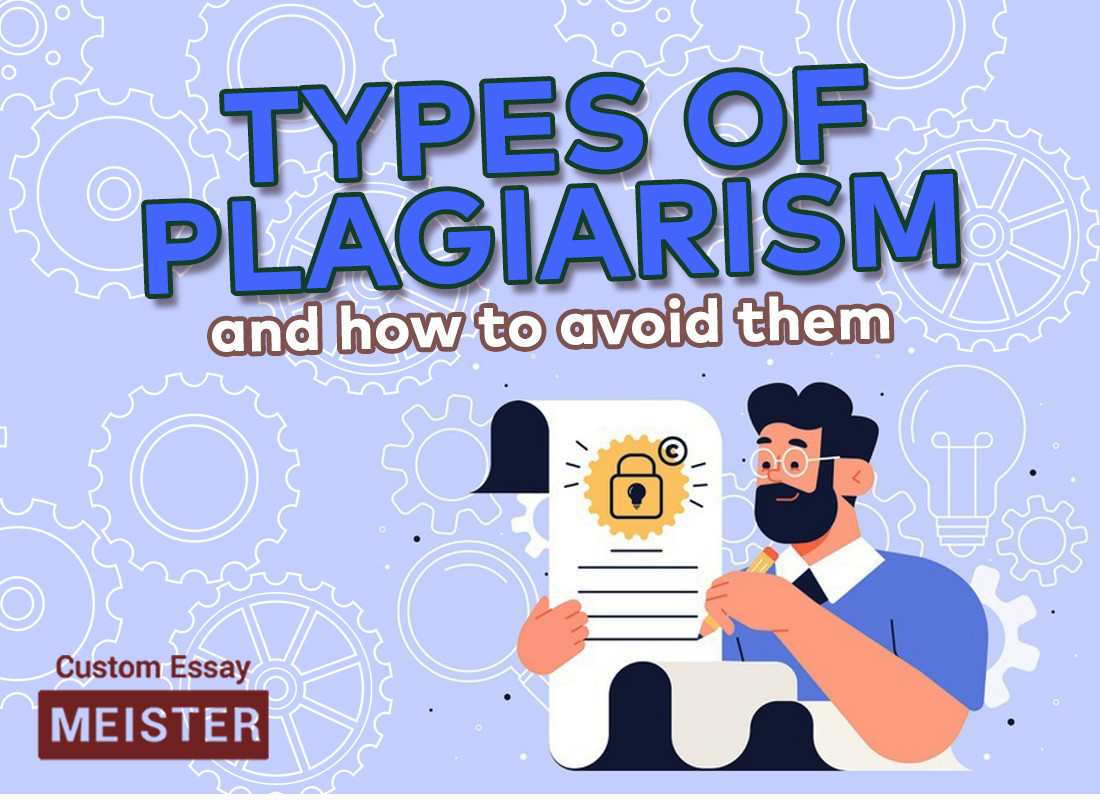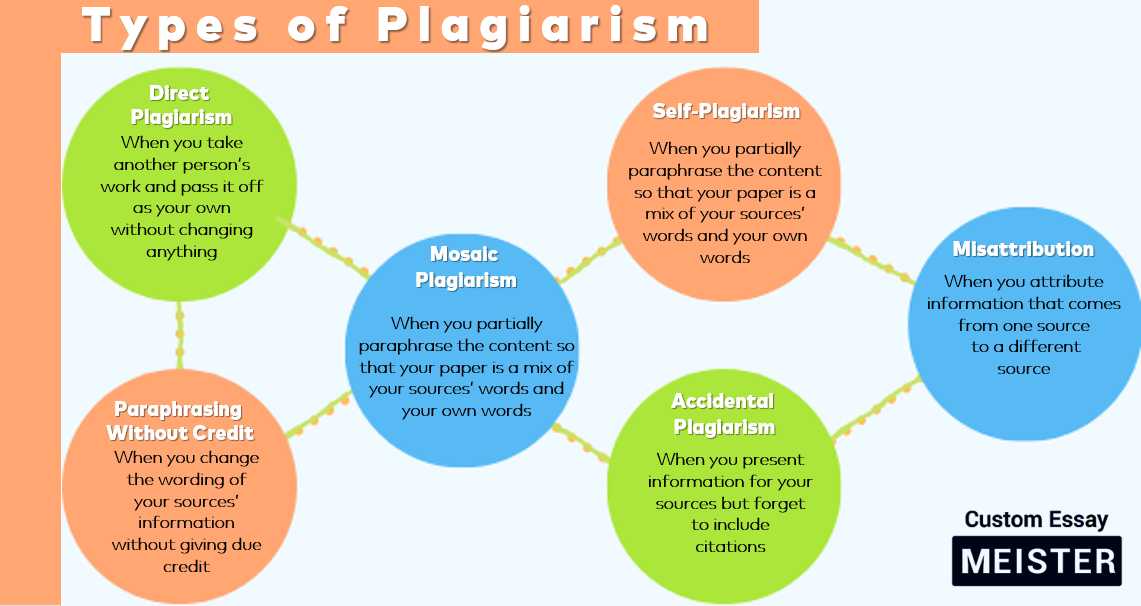15% discount on first order.
Special Welcome Offer.0
days00
hours00
minutes00
secondsTypes of plagiarism

Plagiarism is generally defined as taking someone else’s work and passing it off as one’s own. Plagiarism does not just happen with written works; rather, other types of works such as films, music, and even ideas can be plagiarized. But in the academic setting, plagiarism is submitting written work and making it seem that it is one’s original work. Plagiarism comes in many forms, and knowing what these types of plagiarism are can help you avoid committing it in the first place.
What Are the 6 Types of Plagiarism?
One of the common problems college students face is excessive stress and burnout due to academic problems, and rejected papers are one of many factors why it happens. If you are to avoid such circumstances, it is imperative that you are aware of the different types of plagiarism so your academic writing can go as smoothly as possible. Here are the different types of plagiarism:
Direct plagiarism
Direct plagiarism is one of the most common types of plagiarism. It involves directly copying another person’s work without changing anything. This copied work, in turn, is presented as one’s own without acknowledging the author/source or enclosing it in quotation marks. An example of direct plagiarism is copying sentences or paragraphs from your sources and pasting it on your paper without properly citing quotations from sources. Another example is downloading a paper from the internet and submitting it as your homework.
Here is an example of a plagiarized essay, with a passage lifted straight from an article by Alan Taylor from The Atlantic:
The Nazis expertly used propaganda to turn the German public’s anger and resentment after World War I to cultivate racism toward Jews. Lebensunwertes Leben, or "life unworthy of life". The phrase was applied to the mentally impaired and later to the "racially inferior," or "sexually deviant," as well as to "enemies of the state" both internal and external. The Holocaust started with Nazi policy normalizing and legalizing the murder of civilians en masse, especially the Jews. Later on, the mass murder, or genocide, of the Jews became Hitler’s “final solution.”
Another example is if you downloaded the sample essay on World War I aftermath from CustomEssayMeister.
Paraphrasing without crediting
Another type of plagiarism is paraphrasing someone else’s work without giving credit to the source. The difference between quoting and paraphrasing is that paraphrasing involves taking another’s work and writing it in your own words without acknowledging where the ideas come from.
Using Taylor’s article again, paraphrasing without crediting would look something like this:
The Nazis expertly used propaganda to turn the German public’s anger and resentment after World War I to cultivate racism toward Jews. Jews were associated with descriptors like “lebensunwertes Leben” (“life unworthy of life”), “racially inferior,” “sexually deviant,” and “enemies of the state.” The Nazis planted seeds of anger and racism toward innocent Jews to buttress their plan of murdering Jews and other minorities by the millions.
Mosaic plagiarism
What is mosaic plagiarism? Mosaic plagiarism is related to paraphrasing without crediting. The difference is that in mosaic plagiarism the paraphrasing is only partial. Mosaic plagiarism usually involves partial revision such as replacing certain words with synonyms, adding or deleting a few words here and there, and taking short phrases from the source and lumping them together. The result is that the paper still has the same ideas and structure as the source without giving credit. This type of plagiarism is also known as patchwriting since the work eventually becomes a patchwork of original and plagiarized material.
Compare the original passage with the product of mosaic plagiarism below:
Nazi Germany used some of the most horrific terms in history to designate human beings, Jews in particular, whose lives were unimportant, or those who should be killed. They used the term Lebensunwertes Leben, or "life unworthy of life". The phrase was associated with the mentally impaired and later to the "racially inferior," or "sexually deviant," as well as to "enemies of the state.” From the start of the war, Nazi policies were all directed toward murdering minorities in large numbers, especially targeting Jews. Later on, this policy paved the way for Hitler’s ultimate plan, which is the complete extermination of the Jews.
Self-plagiarism
Self-plagiarism is another type of plagiarism, and this generally refers to submitting work you have submitted before in the past. For instance, submitting a paper on global warming that you wrote the previous year for a course in environmental science and then submitting that paper again this year for a course in climatology can be considered self-plagiarism. Simply combining your previous works to create a new one can also be considered self-plagiarism.
Here is an example combining passages from three sample essays from CustomEssayMeister:
Essay On World War I Aftermath: Racism, The Rise Of Nazi Germany, And The Holocaust
Book Report On Nuremberg Laws And The Escape Of Jews: What Exactly Is The Nuremberg Law?
Research Paper On The German Blood And German Honor: What Is The Essence Of Nuremberg Laws?
The anger and resentment that the German public felt during the post-war years eventually paved the way for the rise of the Nazis. The Nazis were masters of propaganda. It is important to note that antisemitism was already rampant in Europe for centuries. Adolf Hitler and other leaders like Joseph Goebbels were capable of rousing audiences through dramatic speeches and spectacular public events, as well as the Nuremberg Laws. The Nuremberg Laws established a way for determining Reich citizens — initially, anyone with a drop of Jewish blood was automatically considered Jewish and therefore not German (“Nuremberg Race Laws”, n.d.). All those inhumane acts witnessed in the Holocaust had happened under the sheets of the racist Nuremberg Laws.
Accidental plagiarism
Sometimes, plagiarism can be committed even if it is not intended. Such is the case with accidental plagiarism, which usually happens when you forget to cite your sources. During a writing frenzy, you may opt to write everything down and just put citations later. But this can result in accidental plagiarism if ideas that you borrowed from your sources are not attributed properly.
Aside from preventing accidental plagiarism, citing your sources as you write will help you write faster. Check out the tip on how to cite as you go.
Misattribution
Misattribution is a type of plagiarism that involves the attribution of a piece of information to the wrong source. For example, your paper presents statistical data regarding the topic and indicates that the information comes from a journal article by Author X, despite the fact that the information actually comes from an article by Author Y. This can be considered plagiarism because the source is incorrect and the correct source is not given due credit.
An example would be interchanging the two sources in this quote:
The treaty’s imposition of responsibility upon the Germans was further aggravated by the economic disaster that the country went through in the 1920s. The staggering reparations that Germany had to pay resulted in hyperinflation (Schmidt 3-19). The worth of money declined so much that many people simply cannot afford even basic needs. A loaf of bread that cost 250 marks at the start of 1923, for instance, sold for 200,000 million marks towards the end of the same year (“The Weimar Republic 1918-1929”).
Misattributed version:
The treaty’s imposition of responsibility upon the Germans was further aggravated by the economic disaster that the country went through in the 1920s. The staggering reparations that Germany had to pay resulted in hyperinflation (“The Weimar Republic 1918-1929”). The worth of money declined so much that many people simply cannot afford even basic needs. A loaf of bread that cost 250 marks at the start of 1923, for instance, sold for 200,000 million marks towards the end of the same year (Schmidt 3-19).
This type of plagiarism is unacceptable not only because it provides inaccurate information, but also because it shows a lack of respect for the work of others. Students and academics should maintain accuracy and show respect toward the work of their fellows.
As you can see, plagiarism is not always intentional, and it is not simply using another person’s exact words in your paper. Plagiarism is a lot more complicated than a simple copy-and-paste action. Now that you are aware of the six types of plagiarism, you can easily spot why Turnitin or SafeAssign flag some parts of your papers as plagiarized. Knowing the types of plagiarism will hopefully help you write more carefully to avoid plagiarism.
How To Avoid Plagiarism
You do not need to cite every single piece of information you include in your paper. General information, or things almost everyone knows, do not need to be cited. In order to avoid plagiarism, you will need to distinguish between general information, your own ideas, and ideas and information you learned or gathered from other sources. Here are some ways to avoid plagiarism:
- Learn how to quote, paraphrase, and summarize.
- Learn the different citation styles (MLA, APA, Chicago, Harvard).
- Take down notes so you do not get confused about where a piece of information came from.
- When in doubt, cite.
Writing essays, research papers, reaction papers, and dissertations among other academic requirements is such a tough challenge that many students are often tempted to take shortcuts.
However, as difficult as the process may be, plagiarism should be avoided at all costs, and it begins with knowing what plagiarism is and what the different types of plagiarism are. If you find writing without committing plagiarism difficult, you can always hire an academic ghostwriter to help you complete your academic papers or help you edit out plagiarized parts.
Essay writing company that is plagiarism-free
Integrity is the one element that is considered sacred in the academe. Academic papers ought to be as pristine and as impeccable as possible, for they convey valuable information in their respective fields.
This is why our academic ghostwriting services offer only custom written papers, for the purposes of academic integrity. Our essay writing service has been helping students overcome pressure and stress since 2006, thereby helping them lead more balanced and fruitful college lives, because let's face it, college does not revolve around writing alone. Abandon all worry and anxiety, our services are here to help you avoid the different types of plagiarism.
